When it comes to writing successful pitches, everyone agrees:
1. You should never use templates
2. You’ve got to personalise every single email
But how long would it take to write unique pitches for every person that you’re targeting? A few days?
… And what if you’re contacting 100 people? Would that take a full week?
Here’s the deal:
At NeoMam we launch 4 campaigns every week. If we were to spend a week sending the emails for 1 campaign, then we would have a 3-week backlog of campaigns on hold.
Or we could hire 4 people to launch 1 campaign per week each…
But what about the follow ups? Are those also going to take a full week?
Should we then hire 4 more people so that we can launch 4 campaigns per week AND also follow up on those launched the week before?
(Man, this is getting expensive.)
Let’s be real:
It’s not going to happen.
So, what do we do?
Templates. And very good ones too.
“So… Are you saying that you can pitch content to journalists using templates??”
Yes, yes I am. And our 45% reply rate tells me that we’re doing it right.
How? By spending enough time understanding how the content we have in our hands affects people.
Don’t Blame the Template
What I propose is writing templates that feel personal to whoever is reading them.
It’s all about the message and it has nothing to do with the fact that you’re sending it to 100 people.
A good template is like a good book:
- It has an attractive title
- It follows a clear narrative
- It keeps you hooked throughout
- It lets you do the thinking
Of course, there are other factors one should take into consideration such as how good is your content and how targeted is your prospecting. But let’s assume that you’re doing both things right.
So… How do you reach out to these people?
Keep Your Opening Tight
Rule #1 of an email opening:
If you don’t have anything to say, don’t say anything.
Introduce yourself and your business but don’t ramble about your job/your company/why you think their site is the best.
See how we hyperlink NeoMam Studios to our site? If Matt wants to learn more about who is contacting him, then he can click on the link and check out who we are. We don’t need to tell him anything else.
Give Context On Why They Should Care
Here’s where most people get it wrong…
– Hey, XXXXX, you’re pitching a competitor here #prospectingFAIL
You don’t need to tell journalists everything they will find inside of a piece of content to sell it to them. Let them decide whether they want to explore it further by giving them one good reason why they should care.
For example:
Make it about them and not about you, your client or the content itself.
Format The Email to Make Text Easy to Scan
Most of us read our emails while on our phones, so anything that will take more than 2 scroll downs better be bloody good.
– Sorry, XXXXX, I didn’t even get past the salutation here.
If you can’t state the following in 4 sentences…
- Who you are
- Why you’re approaching that journalist and not their colleague
- Why he/she should care
- What is it that you want
… then you’ve got to make it easy for them to skim through your email yet be able to read the most important bits of information.
3 Simple Ways to Make Text Easy to Scan
- Lead with short sentences. If you have a lot to say, break down a paragraph into short sentences whenever possible.
- Bold important bits of info you’d like them to read at first sight.
- Add bulleted lists if there are many points you want to share.
Use ‘Bucket Brigades’ And Ask Questions to Keep Them Engaged
What are ‘Bucket Brigades’ you ask?
“Bucket Brigades are an old school copywriting tactic originally designed to keep people reading sales letters.
Bottom line: whenever you have a section where someone may get bored and leave, add a Bucket Brigade.”
Brian Dean, Backlinko
I’ve dropped plenty of Bucket Brigades around this post and you’re still reading so think about that…
A few Bucket Brigade ideas you might want to try:
– Now:
– What’s the bottom line?
– You might be wondering:
– This is crazy:
– It gets better/worse:
– But here’s the kicker:
– Want to know the best part?
I’ve written a lengthy article for Search Engine Land about the use of bucket brigades in link building outreach, you can read it here.
- Another tip: try to ask questions whenever possible to turn that passive recipient into an active reader.
Would you like to see a template using these techniques?
Chances are you answered that question in your head. That’s exactly what we try to ignite by incorporating questions into our pitch.
BUT
Minimise the chances where you ask a question within your subject line.
Betteridge’s law of headlines states:
Any headline which ends in a question mark can be answered by the word no.
Inside of a pitch we can deal with a ‘no’ but we don’t want that response BEFORE they have even opened the email.
Make The Closing About Them by Giving Just One Choice
One of the biggest mistakes I keep spotting in the pitches we receive, is that of giving the recipient multiple options on what to do with the content.
Look:
If you are giving me three options, I’m likely to choose the one that involves the least amount of effort:
- Ignoring your email, zero effort.
- Sharing on social media, minimal effort.
- Posting your content and writing an article about it, a lot of flipping effort.
If I like your content + I’m super busy + You say a social media share would be a huge help = I’ll share on social media.
Are you sure the one outcome you’re looking for is a share on Twitter? Maybe not.
3 Closing Ideas For Better Content Marketing Campaigns
One email, one desired outcome:
Choose a Publisher’s Headline as Your Subject Line When Following Up
Want to hear the tip I gave Dan about follow-ups when he started working as digital PR assistant a few weeks ago?
When you’re following up with an unresponsive journalist/blogger, you’ve got nothing to lose so try something new.
New subject line, new pitch.
Basically, the opposite to this:
First of all, my reply may very well be ‘yes, I got your email last week’ and I’m sure that won’t be of any use.
One of my best follow-up tips:
Use the headline of a feature as the subject line of your follow-up.
A journalist wrote it, an editor vetoed it and it was good enough for X publisher, so why not have it as a subject line?
A few weeks ago we were promoting a pretty cool new project and one headline from the first batch of features stood out to me:
So what did I do?
I stole it:
I sent 15 emails with that subject line and in the end I got 6 features out of that follow-up round.
Not too shabby.
- If you feel your subject lines need help, you should definitely check out my guide on how to create catchy subject lines for digital PR email outreach.
TL;DR
Every time I get asked to write or talk about pitching content, I feel like there’s nothing I can say that is not common sense.
Writing this article and going through all the pitches we receive on a daily basis made me realise that sometimes common sense is not enough – people need clear guidelines followed by an explanation.
No matter what you read online, anyone can learn how to write effective outreach emails. I’ve trained people from all possible backgrounds and they all have developed their own style of pitching.
If you’re still unsure about whether you can do this, here’s 7 pointers you can take with you:
- Don’t blame the template: Spend your time and write templates that feel personal to whoever is reading them.
- Keep your opening tight: If you don’t have anything to say, don’t say anything.
- Give context on why they should care: Make it about them and not about you, your client or the content itself.
- Format the email to make text easy to scan: Lead with short sentences, bold important bits of info and add bulleted lists if there are many points you want to share.
- Use ‘Bucket Brigades’ and ask questions to keep them engaged: Read http://backlinko.com/seo-copywriting for more info about Bucket Brigades.
- Make the closing about them by giving just one choice: One email, one desired outcome. Let the journalist make one decision.
- When following up, you’ve got nothing to lose: Try a new subject line and a new pitch.
And if all this sounds like a lot of effort:
Next time you sit down in front of a blank email, think about how you’d email a colleague to let them know about a new project you’re working on that you need their help with.
That’s how you do it.
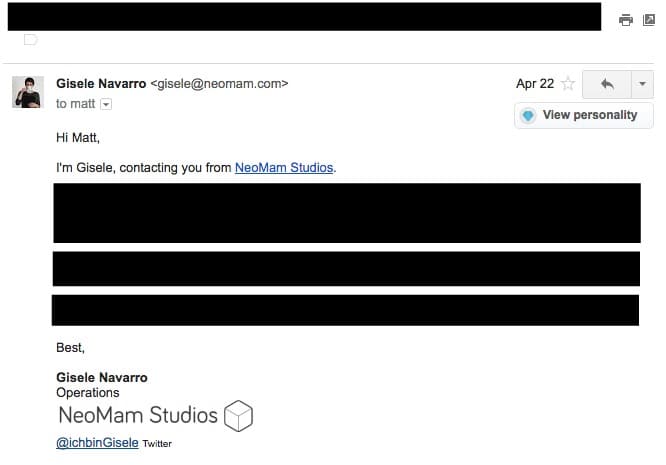
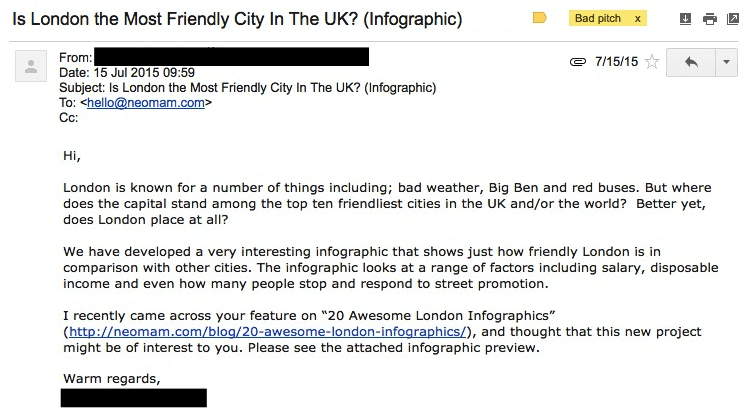
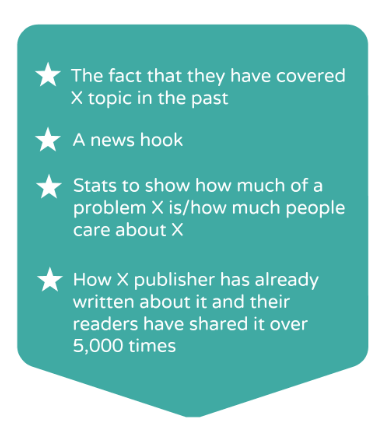
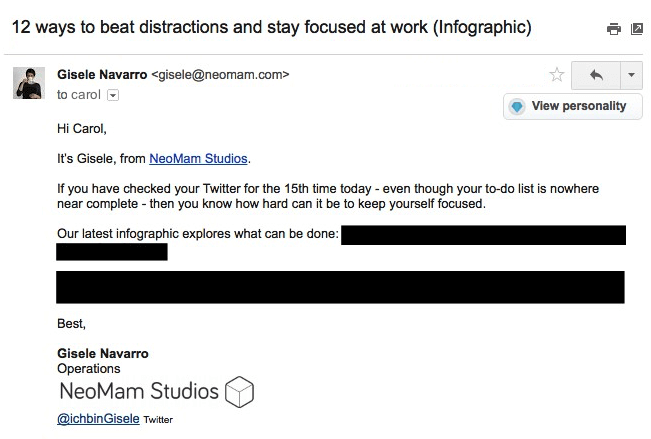
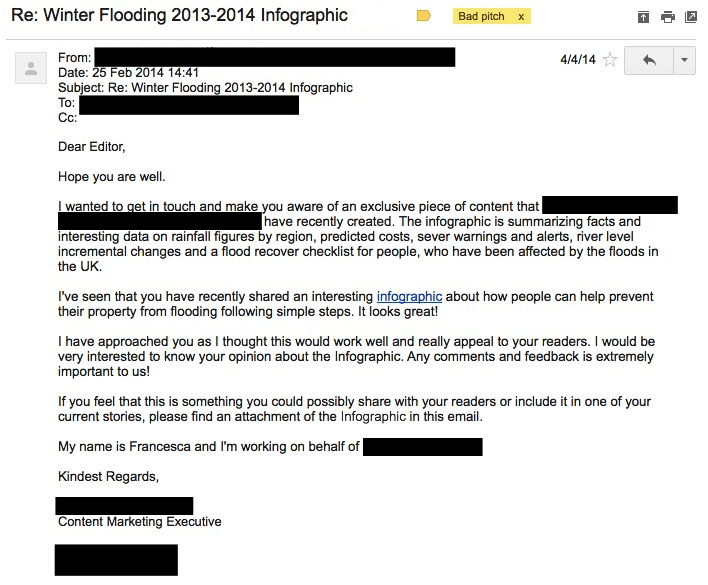
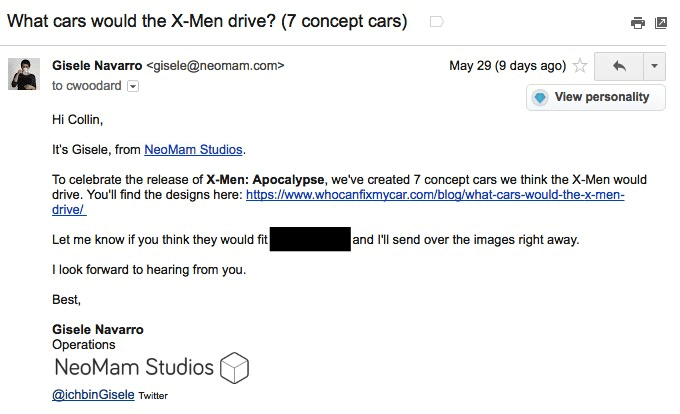
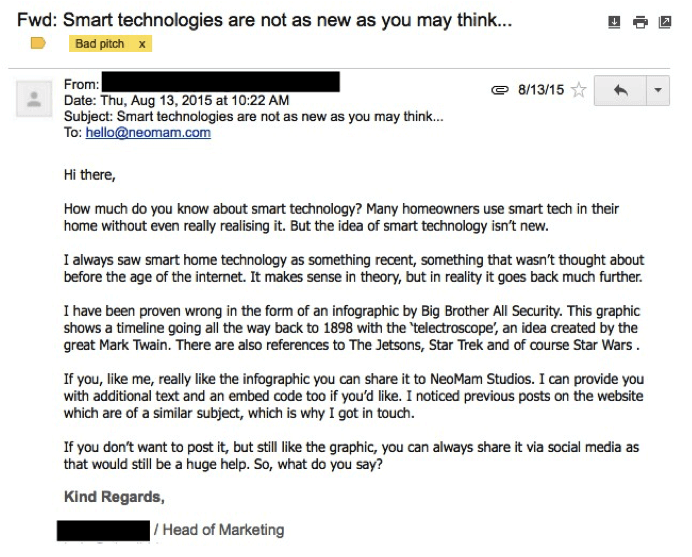
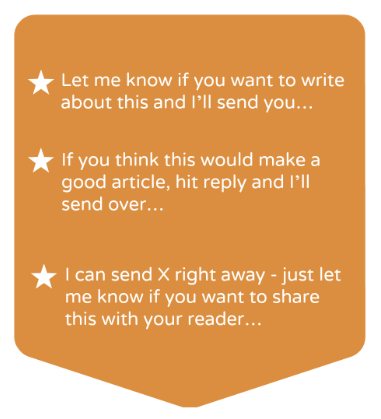
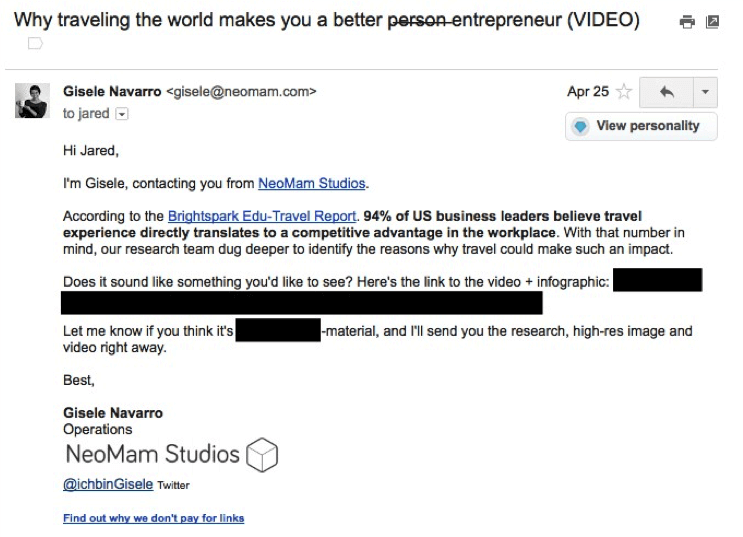
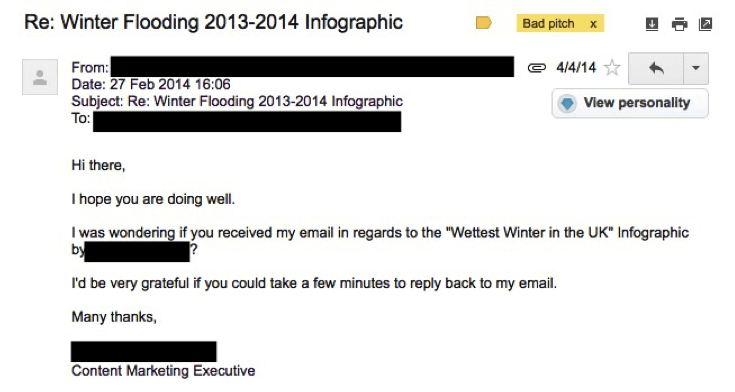

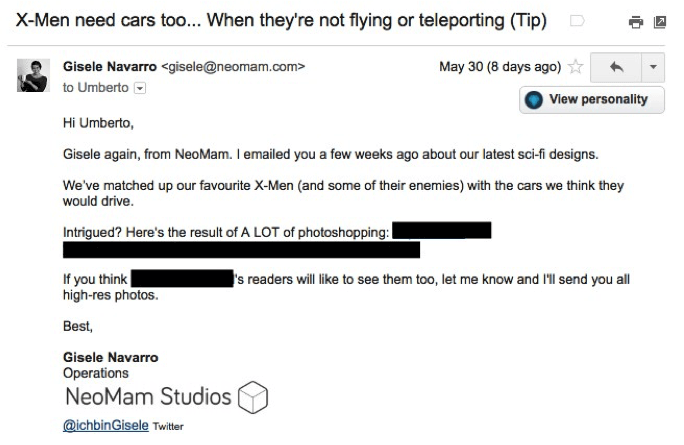
Awesome blog post!
It comes handy… As we are in the midst of …. many email campaigns. Especially I liked the idea of keeping it tight, using bucket brigades, follow up mail as a new pitch, with a new subject line.
Thanks, very helpful.
That’s great to hear, Ravi! Thank you for reading and for taking the time to tell me what was useful – it gives me insight into what I could write about next 🙂
Hi Gisele,
Important topic and you covered it beautifully.
Things that I personally think is crucial when you are creating a sweet outreach email.
1. You have to mention their first name.
2. Format the email scanable.
3. Make it short and to the point.
4. Use always a subject for every email.
By the you mention some more here. Learned many new tricks.
Thanks for sharing
Cheers
Thank you for reading, Riju! And those are some strong 4 points as well
As always a brilliant post from NeoMam. Gisele’s seven pointers combined with my trusted 3×3 pitch template will work wonders, I’m sure.
Thanks,
Tue
PS: for those curios about the 3×3 template it’s based on the idea that no pitch should contain more than 3 paragraphs of 3 sentences each. First paragraph addresses the readers pain(s), the second presents your offering, and the third activates a call to action. Voila!
Thank you, Tue! It means a lot to read you like our posts 🙂 Your 3×3 pitch rule for writing templates sounds like a good formula, thank you for sharing – the more value, the better!
That’s a great article and as well as a great help. It’s really looks great when we see such helpful post.
Thanks.
Thanks, Sourav! Happy to read you found it useful.
Hi Gisele, I read this post last week when I was planning to send a email outreach campaign. I made sure i cover all the point mentioned in this article, and here I am with the results, I got 20% response rate to my emails, which is amazing, Thanks for these great tips.
Hi Shashank, thanks for reading, testing and leaving your feedback. This is great to hear! Keep up keeping up, you seem to be doing a good job 🙂
Hi Gisele, Thanks to you for writing it.
This is the best blog I have read on email outreach to date!
Great tips Gisele! Already bookmarked your article for future reference. Thanks for sharing!
By the way, I think personalization definitely makes the whole approach sound genuine and more effective. But what do you think about making the email sound casual? like using emojis?